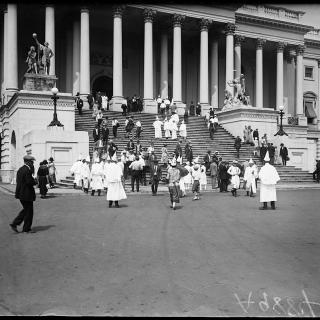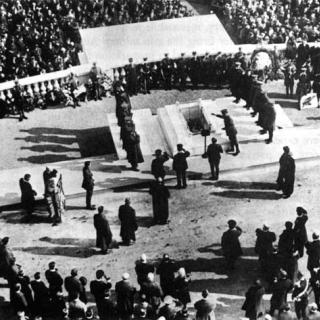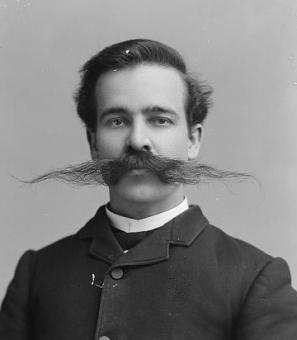The Klan Leaves Its Mark on Washington's Airwaves
It was the roaring '20s and radio was taking off. Americans were tuning-in in droves for news, opera, popular music and sports. No other medium offered the ability to reach so many people instantaneously. Advertisers certainly took note, finding creative ways to slide their messages into America's favorite programs.
So, too, did the resurgent Ku Klux Klan, which was interested in its own sort of advertising: promoting a unique brand of “patriotism” founded upon white privilege and intolerance for blacks, Catholics, Jews, and immigrants amongst others.
After being down for several decades, Klan membership spiked in the mid-1920s nationwide. For Klansmen and sympathizers like James S. Vance, publisher of The Fellowship Forum newspaper, there was no better place to launch a pro-Klan radio station than the nation's capital. (While editors publicly denied Klan affiliations, the Forum was well known to have close ties to the “Invisible Empire.”)
In July 1927, the Independent Publishing Company, the parent company of The Fellowship Forum, submitted paperwork to the Federal Radio Commission seeking approval to purchase the Brooklyn, New York station WTRC and transfer it to Washington.
In describing what he hoped to offer listeners, Vance told the New York Times, “It will be our main object to 'pierce' the ether frequently with talks on pure patriotism by some outstanding American. We shall undertake to give instructions in civil government as it applies to our own country and in comparison with that of other nations.”[1] Other programming would include old fashioned songs and hymns, weekly sermons and lectures about agriculture.
The Commission approved the transfer on an experimental basis but mandated that the station must limit its signal to 50 watts until further review. A few weeks later, Vance relaunched the station – renamed WTFF after his newspaper, which would run it – in Mount Vernon, Virginia. Even though the many broadcasts originated from a studio at The Fellowship Forum's downtown D.C. Office, which was connected to the Mount Vernon site by a direct cable, the station's low signal strength meant that the station struggled to reach some parts of the District. (This was, no doubt, a relief to many.)
In short order, WTFF sought FRC approval to increase its signal strength exponentially. In October, Vance and company aimed high – very high – and submitted an application to increase the signal from 50 watts to 50,000 watts on the frequency of 1,470 kilocycles. As The Washington Post noted, “The request for so great an increase in power as 50,000 watts indicates the desire of the pro-Klan organization to be heard over a large portion of the United States and the application for the short waves, that it wishes to reach foreign countries and other parts of the world.”[2]
Some officials worried that such a powerful station would drown out all the other stations assigned to the same channel nationwide. Indeed, if approved, the proposal would have made WTFF one of the five most powerful stations in the country. It wasn't, but WTFF did receive permission to increase its signal to 10,000 watts two months later.
While not quite the coverage that Vance initially imagined, the increased signal meant that The Fellowship Forum's message would be heard far beyond the District. “People out in the great open spaces are being told over the radio every Wednesday night just who their 'friends' are in Congress and who are not. ... While local folk have to run the dial way down to get the station it has a good reception in the Middle West.”[3]
But, despite its reach, WTFF's days were numbered. By the late 1920s, public sentiment started to turn and Klan membership dropped precipitously. In response, Vance announced his station would change its call letters to WJSV and cease connection with the Forum newspaper. (It would, instead, be managed directly by the parent company, Independent Publishing Co. and treated as a separate business from the newspaper.) When asked if the new station would also be a Klan mouthpiece, Vance answered, “It will run on its own hook. Several advertisers are sponsoring programs and entertainment of the highest order is promised listeners.”[4]
So what did a reeling Klan affiliate equate with “entertainment of the highest order”? Apparently local amateur talent shows, social club broadcasts, and agriculture reports fit the bill.
Still, with its strong signal and location in the nation's capital, WJSV was of great interest to the national radio networks. At various points over the next few years, that station was said to have been targeted by CBS, NBC, and ABC.
In 1932, CBS struck a deal with Vance and took over management of the station. Very shortly thereafter – perhaps after realizing it was in bed with the Klan – a network subsidiary purchased the station outright. In approving the sale, the FRC noted that WJSV had been having difficulty maintaining well-balanced programs of good quality and that the transfer was expected to benefit the listening public.[5]
That proved to be prophetic. The public took a liking to the new station, and it has been one of the highest-rated radio broadcasters in the Washington, D.C. market for years. Since 1943, we've known it as WTOP.
Footnotes
- ^ “Klan Radio Station Seeks 50,000 Watts,” The New York Times, 9 Oct 1927: 6.
- ^ “Station WTFF Asks Increase in Power to Enlarge Scope,” The Washington Post, 9 Oct 1927: 13.
- ^ Bargeron, Carlisle, “Capitol Close-Ups,” The Washington Post, 8 Apr 1928: M4.
- ^ “WRC Wave Will Change on Sunday,” The Washington Post, 9 Nov 1928: 11.
- ^ Heinl, Robert, “Radio Dial Flashes,” The Washington Post, 11 Jun 1932: 9.






![Sketch of the mythical fuan by Pearson Scott Foresman. [Source: Wikipedia]](/sites/default/files/styles/crop_320x320/public/2023-10/Goatman_Wikipedia_Faun_2_%28PSF%29.png?h=64a074ff&itok=C9Qh-PE1)












